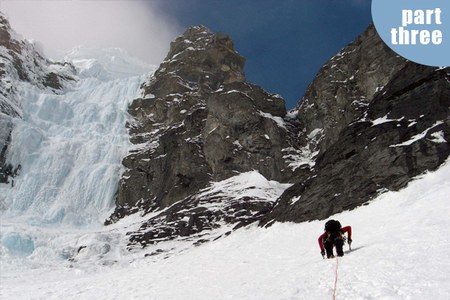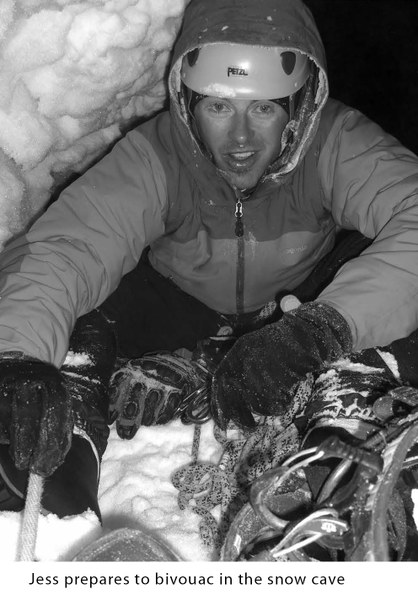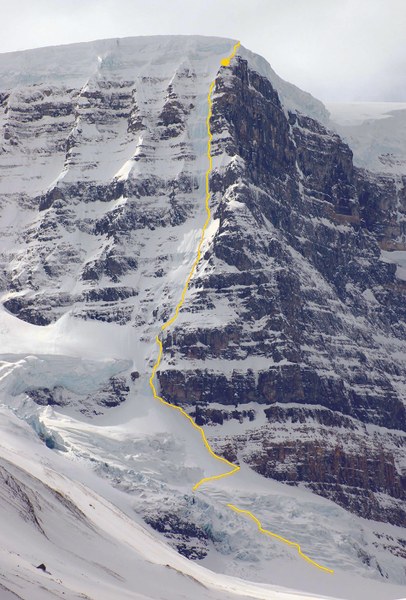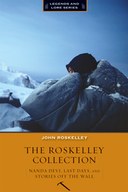
Slipstream, Part 3
BY JOHN ROSKELLEY
Excerpted from The Roskelley Collection, in memory of Jess Roskelley. (See Part 1 and Part 2)
Monday, April 27, 2009
Around 4:00 am, the farthest stars in the east began to fade and a thin red line appeared on the horizon. Cold to the core, we waited impatiently for the sun, which proved reluctant to show itself. Slowly it peeked over the Rockies, broke the horizon, then sent its warmth into the snow cave opening, which was directly in line with its rise by fortuitous accident caused by the angle and direction of the arête. I pulled my painfully cold, bootless feet from the icy pack where I had placed them the night before, and held them to the sun.
“Have you gone mental?” Jess said. “I don’t feel any of the sun’s heat.”
Granted, there was little warmth radiating from the sun’s low angle, but just the sight of sunlight on my socks made my feet feel warmer.
I waited for the air temperature to rise a few degrees before putting on my boots and crawling from the cave. Once outside and standing, I worked to stabilize my stance while digging for our gear, which we’d hastily tossed in the snow the night before. Jess was eager to stand and feel the sun, so we switched places; I went back inside the cave to put on crampons and harness. An hour after the sun’s rise, we were both ready to finish the climb.
“I’ll take the first lead,” I said. “Can you handle the last vertical pitch?” “Yeah, I can do it,” Jess replied. “My hands are really cold, though.”
 I led two hundred feet up the low angled arête that split the north and east faces, wading through knee-deep wind-deposited snow, and stopped to belay fifty feet below the summit ice cap. By climbing the arête, I had avoided the snow-loaded, concave avalanche basin above Slipstream and the vertical rock wall to the north. The belay was directly underneath several minor summit cornices but looked reasonably safe, so I stomped out a small stance on the sugary snow until I was standing comfortably and then placed two ice screws for a belay. I yelled at Jess to climb.
I led two hundred feet up the low angled arête that split the north and east faces, wading through knee-deep wind-deposited snow, and stopped to belay fifty feet below the summit ice cap. By climbing the arête, I had avoided the snow-loaded, concave avalanche basin above Slipstream and the vertical rock wall to the north. The belay was directly underneath several minor summit cornices but looked reasonably safe, so I stomped out a small stance on the sugary snow until I was standing comfortably and then placed two ice screws for a belay. I yelled at Jess to climb.
“It looks as though you might be able to climb the rib,” I suggested when Jess arrived at the belay. “If not, then you’ll have to go around to the north side.” Neither of us could see the north side, but Josephson, our guidebook’s author, made it perfectly clear that it wasn’t a walk in the park: “Either climb the ice arête or boldly traverse onto the north face proper and climb steep water ice to the cornice and then the top.” “How are your hands?” Jess asked.
“They’re cold, but not as bad as yesterday,” I said. “Are you up for leading this?”
“I’ll give it a shot,” he answered, but I sensed that the confidence he had climbed with the day before was missing.
Jess grabbed several extra runners and two more ice screws from my harness, and moved slightly up and to his right thirty feet from my belay. The wind had deposited a thick layer of spindrift over ice, a footing nightmare in the making. After placing two ice screws in rotten, honeycombed ice, Jess tested the direct arête route—obviously the easier line. The ice above was like vertical sand—it was in no condition to climb. He then moved cautiously to the arête’s edge and bent his upper torso and head sideways to see around the arête to the north face. After a brief moment he straightened up, looked toward me, and said, “I’m coming back.”
Reluctantly, I inched over to the north face and peeked around the corner. It was a scene straight from a George Lucas movie. An eagle would have developed vertigo flying over the three-thousand-foot vertical relief and the forbidding wall of black dolomite before me.
“Oh shit,” I said to myself.
“My hands are just too cold to lead that pitch,” Jess said as he caught his breath at the belay. “It looks difficult, but just your kind of ice.”
“Okay, let’s switch places and I’ll finish it off,” I said, with more bravado than I felt.
I wasn’t excited about leading a vertical ice pitch, given how cold and tired I felt, but I also wasn’t about to let Jess know this. He had stepped up the afternoon before and led when I was too cold to do so. Now it was my responsibility to do the same, and my opportunity to make up for my failure to lead the day before. This is what makes a good team—sharing the difficulties as they arise.
I reached Jess’s high point within a few minutes. The arête looked relatively easy, but after hitting it with my ice tools, I agreed with Jess—the snow-ice mix was out of condition and virtually impossible to climb. Reluctantly, I inched over to the north face and peeked around the corner. It was a scene straight from a George Lucas movie. An eagle would have developed vertigo flying over the three-thousand-foot vertical relief and the forbidding wall of black dolomite before me. It was frightening.
I looked back at Jess to make sure he was ready. “Okay, I’m going. I’m not going to put any pins in, so get a good grip,” I forewarned him.
Holding tight to my left ice tool, I leaned over as far right as I could without losing my balance, reached four feet and around the corner, and lightly tapped my ice-hammer pick into the thin veneer of clear blue water ice smeared to the rock. It held. I then crab-legged right with my feet, swung under my tools, and kicked my crampon front points firmly into the ice. Once balanced on the wall like a spider, I pulled my left tool from the east side and tapped it into the ice above me. I was now in classic ice-climbing position, subconsciously aware of the abyss below me but focused on the vertical ice above.
Not much time had gone by, but my hands, encased in partially frozen gloves, were painfully cold as only an ice climber or a North Sea fisherman can appreciate. I had to move fast or lose my grip. Hanging from my tools to place an ice screw with frozen hands was not an option.
Ascending the twenty-five feet of water ice that led to the lip of the ice cap took only a few minutes but a lifetime of experience. It was one of the most spectacular finishes to a summit I have ever climbed. At the top of the ice, I plunged my tools into the almost horizontal soft snow of the summit cap and pulled myself off the face.
Once off the vertical wall, I walked fifty feet from the lip of the face up the easy-angled snow slope, dropped into a sitting belay, dug my heels in the firm snow, pulled in the remaining slack in the rope, and yelled, “Belay on!” Fifteen minutes later, Jess popped over the lip like a whale breaching from the sea.
“What a finish!” he said.
“What a climb!” I replied. “Now let’s get off this bugger.”
It was still early morning, and the summit was eerily quiet and still. A few ice-crystal clouds were forming along the ridges, but we could see forever and then some. Our descent route down the summit slope to the Dome Glacier stretched out before us—tricky, but direct and relatively safe.
On Friday morning, prior to the climb, we had signed out at the Lake Louise Ranger Station thinking we would hike to the base of Slipstream that afternoon and climb Saturday, with a drop-dead return and sign-out on Sunday. Our plans changed due to the weather. We didn’t hike to the base of Slipstream until Saturday, and then climbed all day Sunday. The bivouac put us on the summit Monday morning. We knew the ever-efficient Canadian park rangers would be looking for us first thing that morning. Climbers overdue on Slipstream were a priority.
“You hear that, Jess?” I asked as we started down the long snow slope off the summit.
The steady whump, whump, whump of a helicopter grew louder. Then, just off the lip of the north face of Mount Snowdome, a bright orange-and-white chopper flew into view at eye level. It was the Canadian park rangers’ helicopter checking the route. Three people inside the chopper were looking our way.
I quickly raised my arms and gave them a thumbs-up to signal that we were okay, expecting them to fly by again, give us the same signal in response, and leave us to our descent.
The pilot circled over the east face, then pointed the nose of the chopper toward Mount Snowdome’s summit and came in slowly. Jess and I squatted in place and shielded our eyes from the ice crystals whipped up by the rotor wash. The pilot landed on the slightly rising snow slope to the summit, facing west. As he held the chopper in place, the side door popped open and a park ranger plunged through the deep summit snow and came over to us.
“How you guys doing?” he asked.
“We’re okay,” I said. “I gave you the thumbs-up.”
“Yeah, we know, but since we’re up here we thought we would offer you guys a ride down to save you the trouble of climbing down.”
I looked at Jess. “What do you think? You want to take the ride?”
“Sure, why not?” he replied.
“This won’t be considered a rescue, will it?” I asked.
“Oh, no,” the ranger said. “We’re just practicing, and if it helps you guys out, great!”
“Good enough,” I said.
The ranger helped us coil our rope and stow our tools before the three of us ducked under the rotors and climbed aboard.
“This is going to be the easiest descent I’ve ever had in forty-four years of climbing,” I said to the ranger.
“We’re glad to do it,” he said.
The pilot lifted the chopper vertically a few feet, rotated it 180 degrees, and changed the pitch on the rotors, and we sailed off the summit and over the east face. Within five minutes we touched down at a landing zone near the Columbia Icefield Chalet lodge.
Slipstream was over.
 “Listen, Jess,” I said, once we were wolfing down a cheeseburger and fries in the chalet, “next time you want to climb a route like Slipstream, find someone your own age. I’m getting too old for routes like this.”
“Listen, Jess,” I said, once we were wolfing down a cheeseburger and fries in the chalet, “next time you want to climb a route like Slipstream, find someone your own age. I’m getting too old for routes like this.”
“Okay, Dad,” he replied. “Say, I’ve got my eye on a nice route on Andromeda. You want to give it a try during my next break?”
“Kids never listen,” I thought. But then again . . . “What route do you have in mind?” I asked.
* * End * *
Photo at top: Jess Roskelley approaching the upper vertical waterfalls on Slipstream, 2009
The Roskelley Collection includes legendary climber John Roskelley's three acclaimed books, together for the first time in one volume and all written with self-reflective humor and spellbinding adventure. Also included are two essays about Roskelley's more recent climbs with his son, Jess Roskelley: Slipstream and to the summit of Everest.
 Mountaineers Books
Mountaineers Books

